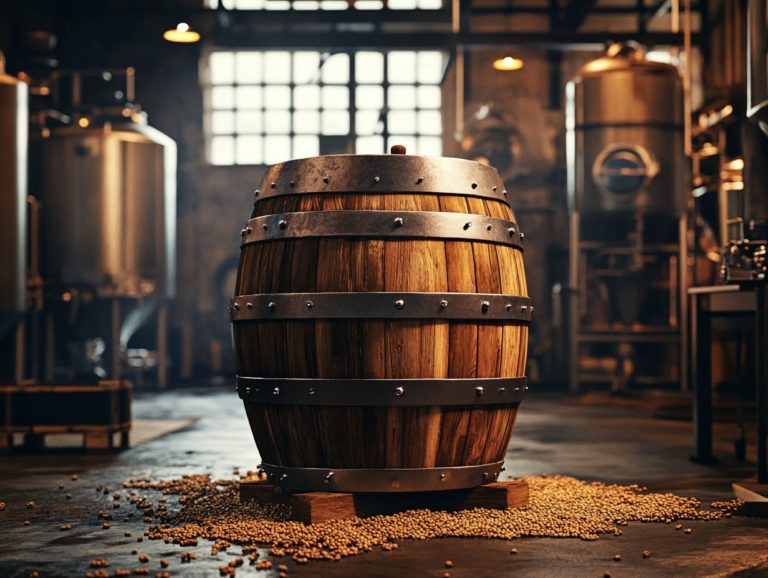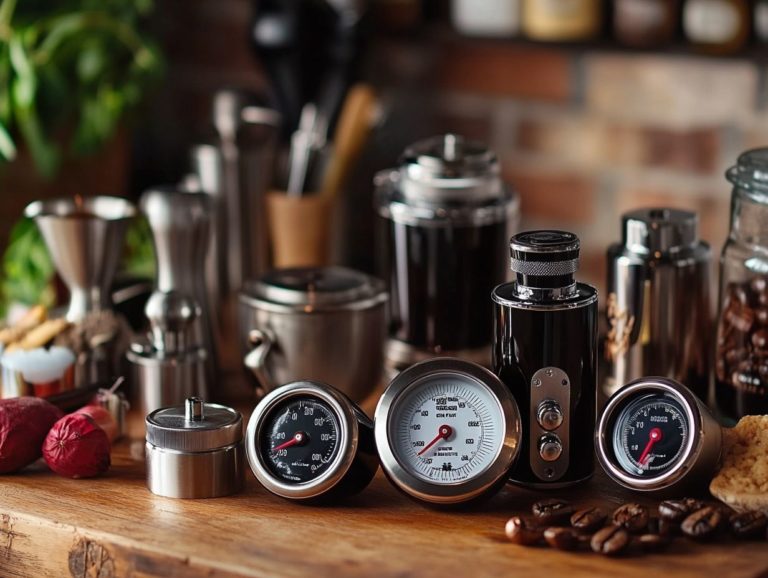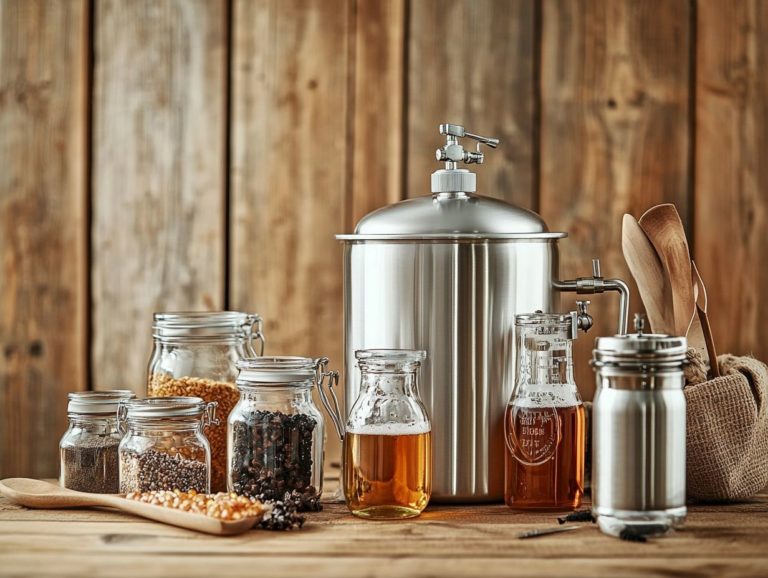Choosing the Right Equipment for Your Beer Style
Beer brewing is a captivating blend of art and science, inviting you to explore a myriad of beer styles that each offer unique flavor profiles, aromas, and brewing techniques. Understanding these distinctions is essential for any aspiring brewer looking to refine their craft.
This article will guide you through the primary categories of beer styles, highlighting how they differ and outlining the specific equipment necessary for each. Whether you identify as an extract brewer, an all-grain aficionado, or you re simply intrigued by specialty techniques, you ll find valuable tips to help you select the right equipment for your brewing adventure.
Embark with us as we unravel the essentials that will elevate your brewing experience to new heights!
Contents
- Key Takeaways:
- Understanding the Different Beer Styles
- Factors to Consider When Choosing Equipment for Your Beer Style
- Choosing the Right Brewing Equipment
- What Is Your Budget for Equipment?
- Essential Equipment for Brewing Different Beer Styles
- Equipment for All-Grain Brewing
- Equipment for Specialty Brewing Techniques
- Tips for Choosing the Right Equipment for Your Beer Style
- Brewing Equipment Guide
- Frequently Asked Questions
- What is the importance of choosing the right equipment for my beer style?
- What factors should I consider when choosing equipment for my beer style and brewery size?
- Can I use the same equipment for different beer styles and brewing methods?
- What are some essential equipment pieces for brewing ales and lagers?
- Do I need to invest in expensive equipment for brewing lagers or any other beer styles?
Key Takeaways:
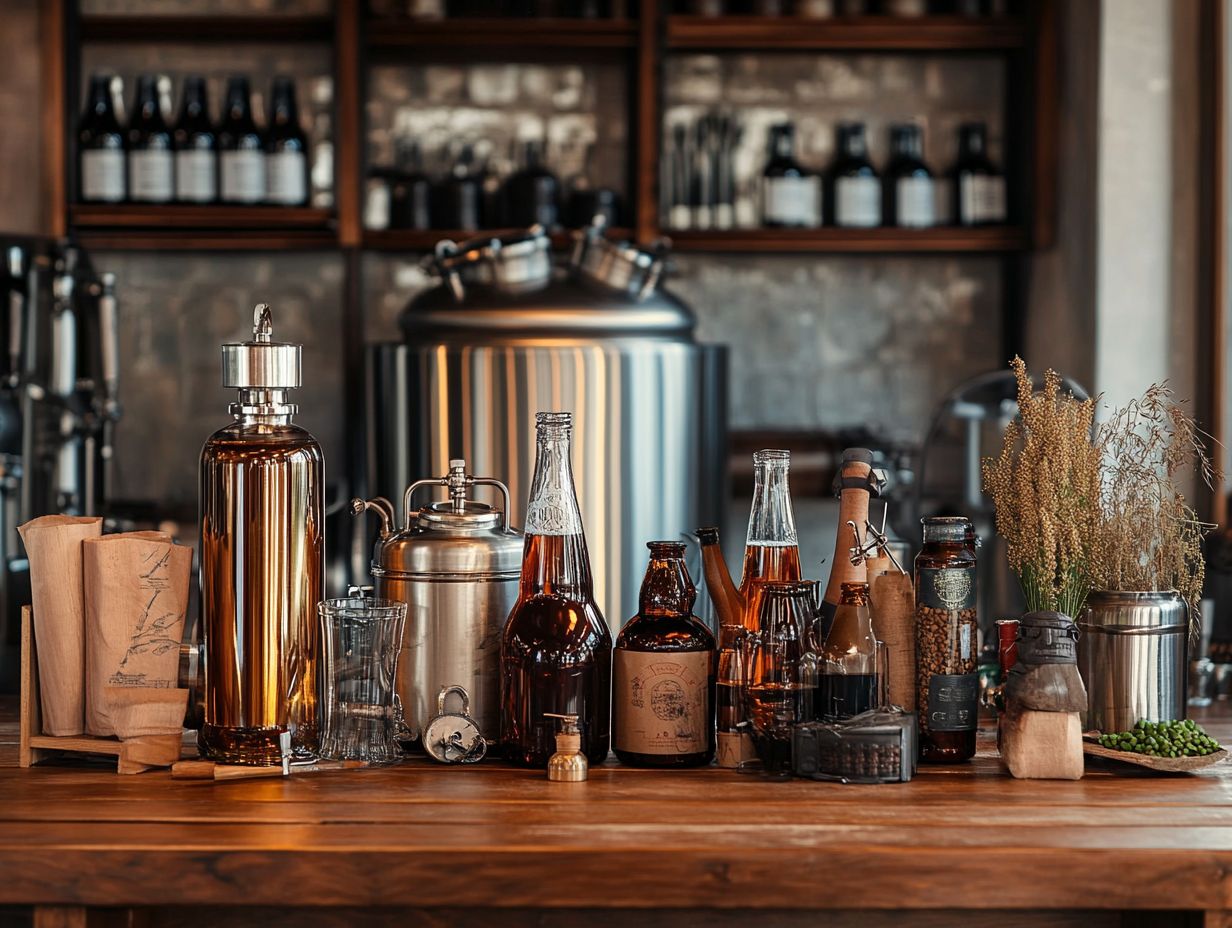
- Understanding different beer styles is crucial in choosing the right equipment for your brewing needs.
- Consider factors like brewing method, equipment size, material, and budget when selecting equipment for your beer style.
- Researching and investing in quality equipment, considering future beer styles, and seeking recommendations from experienced brewers can help in making the best equipment choices.
Understanding the Different Beer Styles
Understanding diverse beer styles is crucial for you, whether you’re just starting out or have some brewing experience. With an impressive array of beer types from IPAs to stouts each style presents unique flavors, aromas, and brewing techniques that require particular equipment and processes.
This knowledge will not only guide your selection of hops and malt but also significantly influence the quality, efficiency, and presentation of your final product. Think about how you’ll use this knowledge to create amazing beers!
What Are the Main Categories of Beer Styles?
The main categories of beer styles can be broadly divided into ales and lagers, each defined by their unique fermentation methods and flavor profiles in the brewing process.
Ales, including IPAs and stouts, are fermented at warmer temperatures using top-fermenting yeast (yeast that rises to the top during fermentation). They typically present a delightful array of fruity and strong flavors thanks to the yeast’s vigorous fermentation.
This leads to various subcategories like pale ales, porters, and Belgian ales, each offering its own unique tasting experiences. For example, a popular craft beer like Sierra Nevada Pale Ale bursts with hoppy flavors, while a rich stout such as Guinness provides a velvety mouthfeel that lingers on the palate.
On the flip side, lagers are celebrated for their clean, crisp taste, with subcategories such as pilsners and M rzen (a traditional German beer). The brewing method for lagers involves a more extended fermentation and aging process, which often results in smooth and refreshing beverages.
This is exemplified by craft favorites like Sam Adams Boston Lager. The variations in yeast types and fermentation temperatures have a significant impact not only on aroma and taste but also on appearance, making each style distinctly appealing to the discerning palate.
How Are Beer Styles Differentiated?
Beer styles are distinguished by a variety of factors that influence your overall experience, including flavor profiles, ingredients, and brewing techniques. The type of malt, the specific hop varieties, the fermentation process, and even the water chemistry all weave together to create the complexity and uniqueness of each style.
As brewers dive into these elements, they can achieve distinct brewing goals. This results in a vibrant selection of craft beers that cater to your diverse tastes.
For example, the alcohol by volume (ABV) can play a crucial role in defining a beer’s character, with some styles showcasing higher ABVs for a more robust experience. Others offer a sessionable strength that invites you to enjoy another round.
Bitterness levels, measured in International Bitterness Units (IBUs), enable brewers to create everything from delightfully bitter IPAs to smooth, malt-forward stouts.
Aroma is another key player in this symphony of flavors. The creative use of specific hop varieties can produce unique fragrance profiles that elevate your tasting experience. Through innovative techniques like dry hopping and barrel aging, craft brewers respect traditional methods while also pushing the envelope. This invites you to savor fresh and unexpected flavors that turn each sip into an adventure.
Factors to Consider When Choosing Equipment for Your Beer Style
When you embark on the brewing journey of brewing various beer styles, selecting the right brewing equipment is crucial for achieving the quality and flavor profiles you desire.
Consider factors such as the size and capacity of your brewing systems and the specific brewing techniques you intend to employ. Your overall brewing goals are equally important.
Budget considerations will also play a significant role in guiding your choice of quality equipment. This impacts everything from containers for fermenting beer to packaging equipment.
This careful planning not only enhances your brewing process but also opens doors to new possibilities. Ensuring compliance with industry standards ultimately leads to successful craft beer production.
What Type of Brewing Method Does Your Beer Style Require?
The brewing method you choose profoundly influences the final product. Each technique brings its own set of benefits and challenges that impact the flavor and quality of your beer, which is crucial for brewery success.
With extract brewing, your process is primarily about boiling water and adding malt extracts. This simplicity means you only need basic equipment, typically just a large pot, a fermenter, and some sanitation gear.
On the other hand, if you venture into all-grain brewing, be prepared for a more intricate setup that includes mash tuns, sparging equipment, and temperature control devices. This method centers on utilizing whole grains and mastering mashing techniques.
While this added complexity extends your brewing time, it also opens the door to an impressive range of beer styles. This makes it particularly appealing to those who are more experienced and eager to delve into the subtleties of their craft the significant aspect of brewery research.
By carefully selecting a method that matches your skill level and desired outcomes, you have the opportunity to elevate the quality of your creations and explore a vast array of unique flavor combinations.
Choosing the Right Brewing Equipment
What Size Equipment Do You Need?
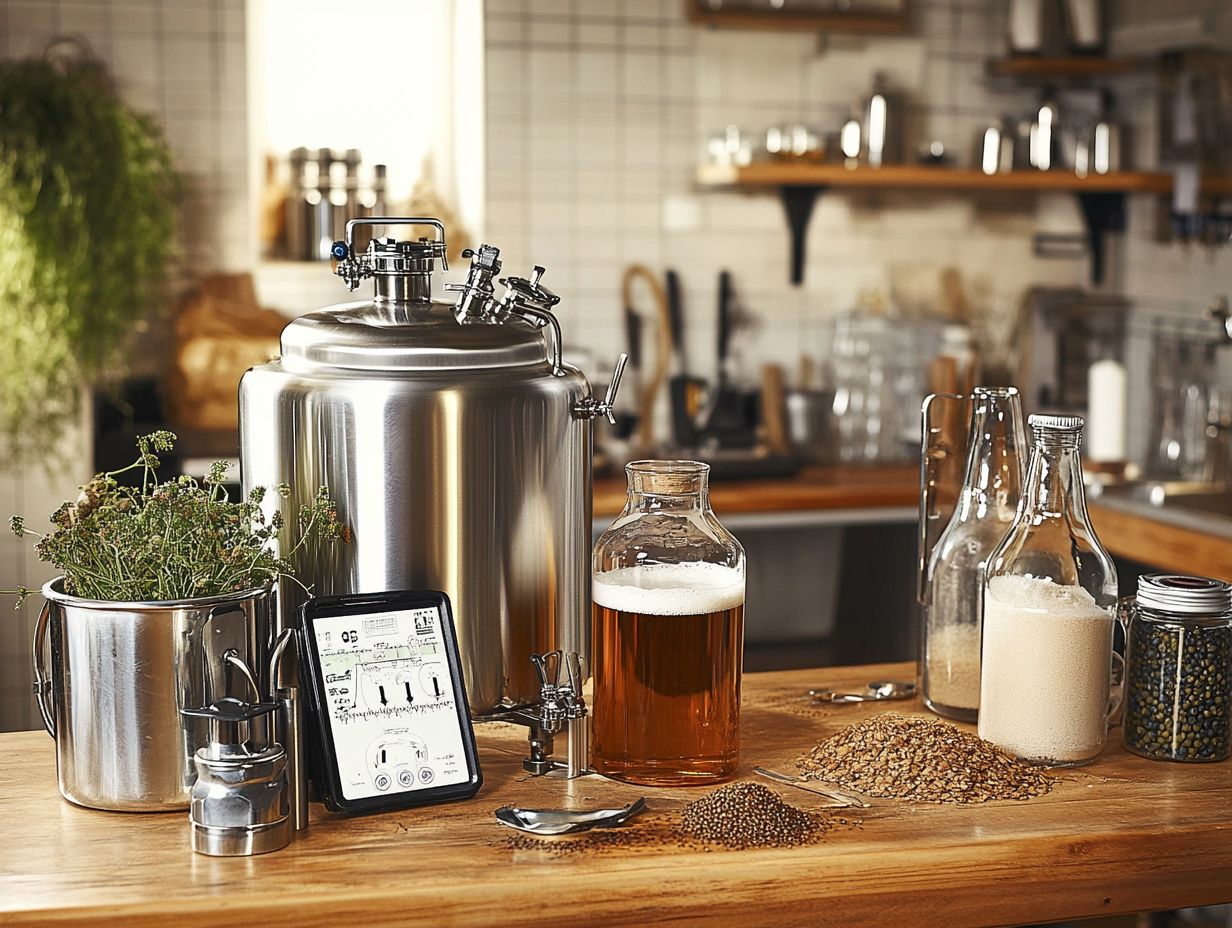
Choosing the right size of brewing equipment is absolutely vital for you to meet your production goals and ensure efficiency in your brewery operation.
Whether you’re setting up a cozy home brewing system or planning for a larger commercial brewery, the dimensions of your brewing kettle and fermentation tanks must align perfectly with your brewing capacity and inventory requirements.
A thorough assessment of your brewing needs will give you the power to select equipment that not only maximizes brewing quality but also minimizes operating costs.
To accurately gauge your brewing capacity, it s essential to anticipate your expected production volumes and the specific beer styles you want to create in your brewery setup.
Different styles may require distinct fermentation processes and storage solutions. Keeping this in mind is crucial.
Balancing the scale of your operation with budgetary constraints can be a tricky endeavor, yet it s essential for sustainable growth in the brewing industry.
By considering the ability to grow from the very beginning, you set the stage for smoother transitions during expansion phases, ensuring that your brewing setup can handle increased production without demanding significant additional investment.
This foresight improves your ability to manage your inventory, allowing you to stay ahead of market demands while minimizing excess stock and the operating costs that come with it.
What Materials Should Your Equipment Be Made Of?
The materials you choose for your brewing equipment play a pivotal role in the brewing process and the overall quality of the beer you produce. For instance, stainless steel often stands out as the material of choice for brewing systems due to its remarkable durability, corrosion resistance, and ease of cleaning.
This ensures that your fermentation tanks and brewing kettle uphold the highest standards of hygiene and flavor integrity. Choosing the right materials is key to brewing success!
On the flip side, glass presents the advantage of being non-reactive, allowing you to visually monitor the brewing process, a crucial aspect of home brewing. But be careful! Glass can break easily.
Plastic, while lightweight and budget-friendly, can sometimes become a breeding ground for bacteria if not meticulously maintained, so hygiene should always be at the forefront of your priorities.
Copper, revered for its exceptional thermal conductivity, can elevate the flavor profile by reacting with sulfur compounds, making it a coveted option for specific brewing stages, particularly in a brewpub equipment setup.
Ultimately, grasping the properties of these materials will give you the power to select equipment that aligns with your unique brewing goals, ensuring both flavor excellence and operational efficiency.
What Is Your Budget for Equipment?
Establishing a budget for your brewing equipment is a crucial step in your brewery planning process, as it dictates the quality and type of equipment you can procure. By carefully considering your financial resources and exploring potential brewery funding options, you can ensure that you’re investing in the right tools to meet your brewing needs without sacrificing quality.
A well-thought-out brewing project budget will support your brewing journey by aligning your equipment choices with your goals and enhancing your operational efficiency.
To create a well-structured budget, make sure to prioritize the essential equipment necessary for your operations while also keeping in mind long-term investments that can yield significant returns. Allocating funds for high-quality machinery might seem intimidating at first, but it often leads to improved production efficiency and longer-lasting equipment, ultimately saving you money over time.
By exploring various brewery funding options available in the brewing industry such as government grants, commercial loans, and potential partnerships you can unlock greater financial flexibility for your brewery setup. This strategy not only eases immediate financial pressures but also positions you for sustainable growth in a competitive marketplace.
Essential Equipment for Brewing Different Beer Styles
Grasping the essential equipment needed for brewing different beer styles is crucial for ensuring consistency and quality in your brewing journey.
Each beer type calls for specific techniques and tools, including containers that help beer ferment, brewing kettles, and packaging equipment, all meticulously designed to cater to the desired styles and flavor profiles. Understanding the brewing methods and brewing techniques specific to each style can significantly enhance your brewing quality.
By choosing to invest in high-quality brewing equipment, you can elevate your production capabilities and craft exceptional beers that truly shine in the competitive landscape of the brewing industry.
Equipment for Extract Brewing
In terms of extract brewing, you’ll find that the essential equipment consists of a brewing kettle, fermenter, and various tools designed to simplify the entire brewing journey, including automation needs for enhanced efficiency.
The brewing kettle is the heart of your operation, where you’ll boil malt extracts and introduce hops to create the foundation of your beer. This step is vital in both commercial breweries and home brewing, emphasizing the importance of selecting good-quality equipment.
A reliable fermenter is crucial, as it allows you to control the fermentation process and ensures that the desired flavors and aromas develop effectively during this pivotal stage of beer production.
To achieve the best results, consider investing in quality equipment and essential tools such as:
- Invest in a hydrometer to monitor the density of the liquid.
- Use a thermostat for precise temperature control.
- Utilize airlocks to prevent contamination during fermentation.
When selecting your brewing equipment, choose high-quality materials like stainless steel for durability and ease of cleaning. Reliable materials are crucial for maintaining brewery compliance and brewery safety standards. Maintenance is key; regularly sanitizing your tools and checking for any signs of wear will help guarantee a successful brew every time.
While extract brewing offers the advantages of faster production times and a more straightforward process, it does present challenges, such as potential limitations in flavor complexity compared to all-grain brewing, particularly in achieving a diverse brewing repertoire.
Start planning your brewery today for a successful brewing adventure!
Equipment for All-Grain Brewing
All-grain brewing demands a specific set of equipment tailored to the intricate brewing process. This includes a mash tun, a lauter tun, and fermentation containers. Investing in such brewing equipment can help optimize your brewing goals.
In the mash tun, you steep the grains in hot water to extract those precious fermentable sugars. Then, the lauter tun comes into play, helping you separate the wort from the spent grains. This is a vital step in crafting the flavor profile of various beer styles.
Selecting and utilizing this equipment properly is essential for anyone aiming to produce high-quality craft beers.
Beyond these core components, there are additional tools that elevate your brewing experience. Kettles are crucial for boiling the wort, allowing you to incorporate hops and other additives that enhance aroma and bitterness.
Meanwhile, chillers swiftly cool the wort after boiling. This process is critical for preventing unwanted bacterial growth and ensuring that yeast can be pitched at the optimal temperature.
By investing in top-notch materials and maintaining precise control over your temperatures and timings, you can significantly improve extraction efficiency and elevate the flavor nuances in your brews. This precision is essential for ensuring successful beer production.
Equipment for Specialty Brewing Techniques

Brewing specialty beers often requires you to embrace unique techniques and specialized equipment to craft distinct flavors and aromas that set your brews apart. This might mean investing in additional fermentation tanks for secondary fermentation, barrel aging systems, or brewing kettles tailored for specific methods like sour or smoked beer production.
With the right equipment in your arsenal, unleash your creativity to craft adventurous flavors and textures! These experiments might include using hops and malt in innovative ways to create unique flavors.
Consider techniques like dry hopping (infusing enticing aromas without the bitterness that often accompanies hopping). This may require specific hop containment devices to ensure you achieve the perfect balance.
Using glycol chilling systems for precise temperature control during fermentation is essential for attaining the desired characteristics of your specialty brews.
Implementing devices such as mash tuns that facilitate step mashing can unlock various sugars, leading to a more complex and layered taste profile. Utilizing advanced cooling equipment also enhances temperature control during the brewing process.
By prioritizing quality equipment, you not only refine your craft but also push the boundaries of flavor exploration. This results in truly unique and memorable beer experiences, ensuring you stay competitive in the craft brewing industry.
Tips for Choosing the Right Equipment for Your Beer Style
Selecting the right equipment for your specific beer style is vital for attaining the highest quality and consistency in your brewing. It demands careful thought about your brewing methods, the outcomes you wish to achieve, and the resources at your disposal.
Reaching out for recommendations or consulting seasoned brewers can offer invaluable insights that will refine your decision-making process. Engaging in brewing consultations with experts can help tailor your equipment choices to your specific needs.
By thoughtfully aligning your equipment choices with your brewing aspirations, you set yourself up for greater success in your craft beer journey.
Brewing Equipment Guide
Research and Compare Different Equipment Options
Conducting thorough research and comparing different equipment options is essential for selecting the best brewing gear. Dive into product reviews, consult with fellow brewers, and check the quality and how long the materials will last. This diligent approach enhances your brewing quality and efficiency.
Explore online resources such as brewing forums and specialty websites for valuable insights into the latest trends and technologies. Industry publications provide in-depth analyses of various brewing equipment, equipping you with a detailed understanding of performance metrics.
Attending trade shows presents a unique opportunity to witness equipment in action and compare different brands side by side. This is particularly valuable for evaluating brewing systems and brewery automation solutions. By engaging with manufacturers and fellow brewers at these events, you can gather firsthand experiences that further aid your decision-making.
Altogether, these efforts enrich your knowledge and foster connections within the brewing community, paving the way for more successful brewing ventures.
Consider Future Beer Styles You May Want to Brew
When selecting your brewing equipment, it’s essential to consider not just your current beer style preferences but also the exciting possibilities of future styles you may want to explore. The flexibility of your equipment can greatly influence your ability to expand your brewing repertoire, allowing you to dive into new flavors and techniques without needing to invest in entirely new systems.
This ensures efficient brewery operation and can reduce overall brewery operating costs, which is particularly beneficial for a brewery expansion. By planning for your future brewing ambitions, you can allocate your resources wisely and ensure that your equipment aligns with your long-term vision for your brewery.
For example, investing in a multifunctional brewing system could allow you to transition effortlessly from brewing IPAs to crafting stouts, or even venturing into the realm of sour beers. To make the best choice, consider looking into how to choose the right brewing equipment. A quality mash tun, capable of handling both smaller and larger batches, will be invaluable as you adapt to the ever-changing preferences of your consumers.
Additionally, temperature control systems that provide precise fermentation adjustments can significantly enhance the quality of a diverse range of beer styles and increase brewing efficiency. Ultimately, this kind of versatility not only maximizes your brewing potential but also provides a cost-effective strategy for scaling your operations as new trends emerge in the industry.
Invest in Quality Brewing Equipment for Better Results
Investing in high-quality brewing equipment ensures you create the best beers possible! When you choose high-quality materials and craftsmanship, you enhance brewing efficiency while elevating the overall flavor and consistency of your craft beer.
By prioritizing quality over cost, you can reduce maintenance issues and ensure the longevity of your equipment, leading to more successful brewing outcomes and lower brewery operating costs. Using premium components significantly minimizes the risk of contamination, ensuring that each batch retains its intended flavor profile.
This dedication to quality not only enhances your reputation as a brewer but also fosters customer loyalty, as consumers begin to appreciate the unique tastes that emerge from a thoughtfully crafted product. Proper brewing maintenance further ensures the consistent quality of your beer.
Investing in advanced technology, such as precise temperature controls and state-of-the-art fermentation tanks, streamlines your brewing process, allowing for better scalability and reduced operational costs, which is crucial for brewery success.
Ultimately, when you leverage high-quality materials and equipment, you create a winning recipe that not only satisfies your craft but also resonates with enthusiasts seeking excellence in every sip. Considerations for automation needs and brewery expansion are also key for long-term success.
Ask for Recommendations from Experienced Brewers
Seeking recommendations from experienced brewers can offer you invaluable insights that will significantly inform your equipment selection process. By networking with industry professionals and participating in brewing consultations, you ll gain a deeper understanding of what equipment works best for various beer styles. You’ll also learn about common pitfalls to avoid, including advice on brewery design and compliance.
Leveraging the knowledge of seasoned brewers allows you to make well-informed decisions that enhance both your brewing quality and operational success. This is particularly valuable for brewery setup and operations.
Building relationships in the brewing community opens exciting doors for collaboration and mentorship, benefiting both novice and seasoned brewers alike. Engaging with others who share your passion for brewing can unlock avenues for sharing techniques, innovative ideas, and troubleshooting solutions. This engagement can also lead to better brewery funding and investment equipment choices.
Forming bonds with fellow brewers may lead to mentorship from those who have navigated similar challenges. This can effectively accelerate your brewing journey and provide insights into brewing project management.
Ultimately, these connections can become a robust support network that enhances your overall competence, encourages experimentation, and ignites creativity in the craft of brewing. This network can also assist with brewery inventory management and sourcing quality brewing materials.
Visit the Brewers Association website for more resources on brewing techniques and industry standards.
Frequently Asked Questions
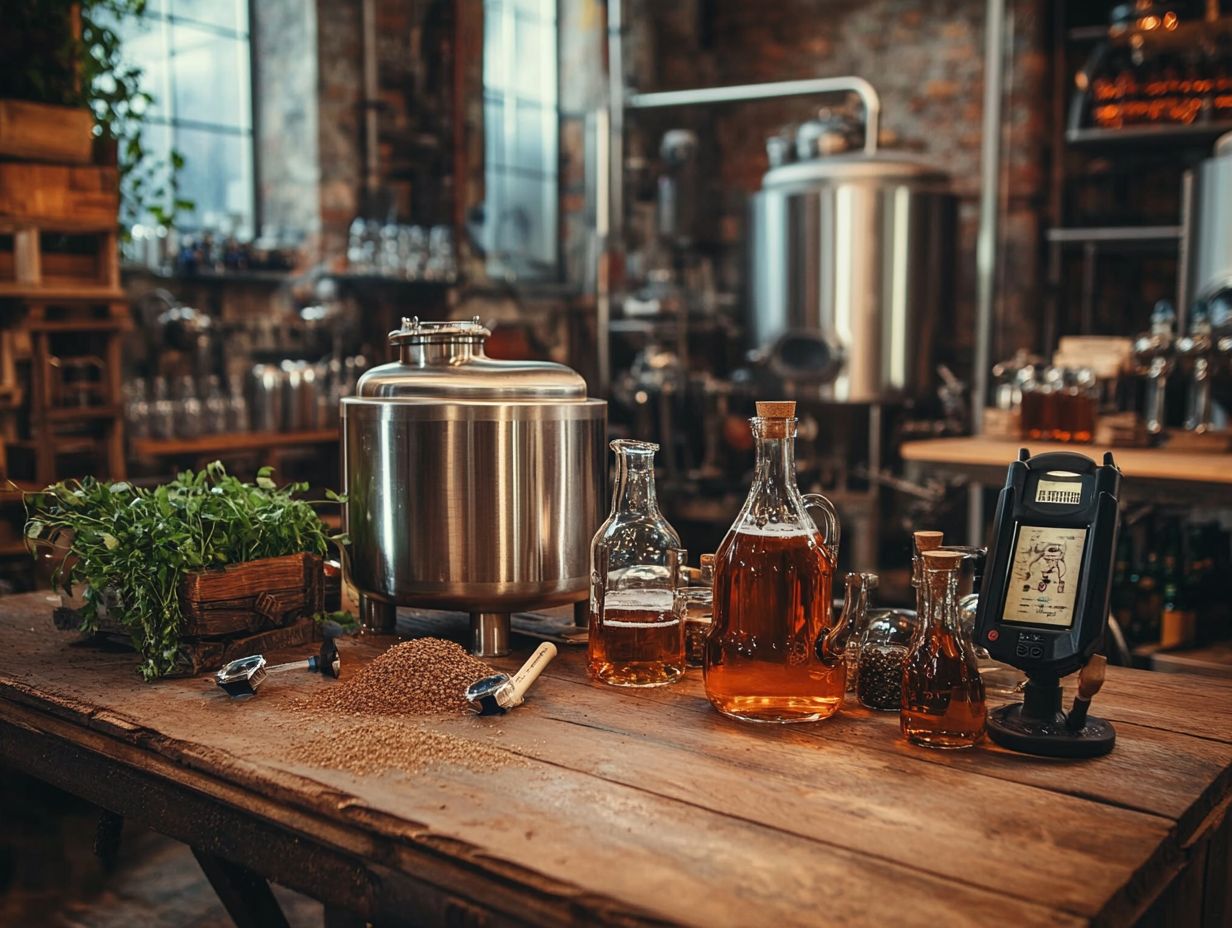
What is the importance of choosing the right equipment for my beer style?
Choosing the right equipment for your beer style is crucial because it can greatly affect the taste, aroma, and overall quality of your beer. Each beer style has specific requirements, and using the wrong equipment can result in a subpar or even undrinkable brew.
What factors should I consider when choosing equipment for my beer style and brewery size?
Important factors to consider when choosing equipment for your beer style include the type of beer you are brewing, the batch size, and your experience level. You should also take into account the availability of equipment, your budget, and any space limitations you may have. Brewery size and licensing are also crucial factors in your decision-making process.
Can I use the same equipment for different beer styles and brewing methods?
While some equipment may be versatile and suitable for multiple beer styles and brewing methods, it is generally recommended to use specific equipment for each style. This will ensure that you can achieve the desired flavor and characteristics of each beer style without any interference from previous brews.
What are some essential equipment pieces for brewing ales and lagers?
The essential equipment for brewing ales includes a large brew pot, a fermenter, a thermometer, an airlock, a siphon, and bottles or kegs for storing the finished beer. It is also recommended to have a hydrometer for measuring the specific gravity of your beer. Additionally, a stainless steel brewing kettle and malt leaching systems can optimize your brewing process.
Do I need to invest in expensive equipment for brewing lagers or any other beer styles?
While some equipment may be pricier, it is not necessary to spend a lot of money on equipment for brewing lagers or any other beer styles. Key equipment for lager brewing includes a fermentation chamber, temperature control devices, and a lager yeast strain. These can often be found at affordable prices and can greatly improve the quality of your lagers. Consider brewery equipment financing to manage your budget effectively.
What are some alternative equipment options for homebrewers on a budget and commercial breweries?
Alternative Equipment Options
If you are on a budget, there are still plenty of equipment options available for brewing your beer.
Some alternatives to traditional equipment include using a large stockpot for boiling, using a plastic bucket or cooler again as a fermenter, and using plastic soda bottles for bottling.
You can also buy used equipment or find DIY tutorials to create your own brewing tools.
For commercial breweries, investing in high-quality equipment from Craftmaster Stainless and YoLong Brewtech will pay off in the long run, ensuring your brewing process is top-notch!

